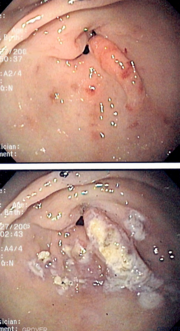Gastric antral vascular ectasia: Difference between revisions
No edit summary |
No edit summary |
||
| Line 39: | Line 39: | ||
* [[Chronic renal failure]] | * [[Chronic renal failure]] | ||
* [[Collagen vascular disease]]s, particularly [[scleroderma]] | * [[Collagen vascular disease]]s, particularly [[scleroderma]] | ||
==Causes== | |||
65% of patients with both cirrhosis and GAVE are male, but a total of 30% have both conditions.<ref name=rare /> The causal connection between cirrhosis and GAVE has not been proven. | |||
A [[connective tissue]] disease has been suspected in some cases. | |||
Autoimmunity may have something to do with it,<ref name=RNA>{{cite journal |doi=10.1093/nar/24.7.1220 |last1=Valdez |first1=BC |last2=Henning |first2=D |last3=Busch |first3=RK |last4=Woods |first4=K |last5=Flores-Rozas |first5=H |last6=Hurwitz |first6=J |last7=Perlaky |first7=L |last8=Busch |first8=H |title=A nucleolar RNA helicase recognized by autoimmune antibodies from a patient with watermelon stomach disease |journal=Nucleic Acids Research |volume=24 |issue=7 |pages=1220–4 |year=1996 |pmid=8614622 |pmc=145780}}</ref> as 25% of all sclerosis patients who had a certain anti-RNA marker have GAVE.<ref name=risk /> RNA autoimmunity has been suspected as a cause or marker since at least 1996. | |||
One theory current since the 1990s focuses on a history of [[prolapse]] of the stomach into the [[small intestine]]. | |||
[[Gastrin]] levels may indicate a hormonal connection. This may be due to a "vasoactive intestinal peptide and 5-hydroxy-tryptamine…". | |||
It is also possible that infection by ''[[H. pylori]]'' can cause it.{{cite}} | |||
==Differentiating Gastric antral vascular ectasia from other Diseases== | ==Differentiating Gastric antral vascular ectasia from other Diseases== | ||
Revision as of 15:05, 5 September 2012
| Gastric antral vascular ectasia | ||
 | ||
|---|---|---|
| Endoscopic image of gastric antral vascular ectasia seen as a radial pattern around the pylorus before (top) and after (bottom) treatment with argon plasma coagulation | ||
| DiseasesDB | 29505 | |
| MeSH | C06.405.748.280 | |
Editor-In-Chief: C. Michael Gibson, M.S., M.D. [1]
Synonyms and keywords: Watermelon stomach; GAVE
Overview
Gastric antral vascular ectasia is an uncommon cause of chronic gastrointestinal bleeding or iron deficiency anemia. The condition is associated with dilated small blood vessels in the antrum, or the last part of the stomach. It is also called watermelon stomach because streaky long red areas that are present in the stomach may resemble the markings on watermelon[1].
Historical Perspective
The condition was first discovered in 1952, and reported in the literature in 1953.[2] Watermelon disease was first diagnosed by Wheeler et al. in 1979, and definitively described in four living patients by Jabbari et al. only in 1984. As of 2011, the etiology and pathogenesis are still not known.[3] However, there are several competing hypotheses as to various etiologies.
Pathophysiology
GAVE is characterized by dilated capillaries in the lamina propria with fibrin thrombi.
Microscopic Pathology

Asociated Conditions
GAVE is associated with a number of conditions, including
Causes
65% of patients with both cirrhosis and GAVE are male, but a total of 30% have both conditions.[4] The causal connection between cirrhosis and GAVE has not been proven.
A connective tissue disease has been suspected in some cases.
Autoimmunity may have something to do with it,[5] as 25% of all sclerosis patients who had a certain anti-RNA marker have GAVE.[6] RNA autoimmunity has been suspected as a cause or marker since at least 1996.
One theory current since the 1990s focuses on a history of prolapse of the stomach into the small intestine.
Gastrin levels may indicate a hormonal connection. This may be due to a "vasoactive intestinal peptide and 5-hydroxy-tryptamine…".
It is also possible that infection by H. pylori can cause it.Template:Cite
Differentiating Gastric antral vascular ectasia from other Diseases
GAVE should be differentiated from other causes of intestinal bleeding such as
The differential diagnosis is important because treatments are different.
Epidemiology and Demographics
Age
The average age of diagnosis for GAVE is 73 years of age for females, and 68 for males. Patients in their thirties have been found to have GAVE. It becomes more common in women in their eighties, rising to 4% of all such gastrointestinal conditions.
Gender
Women are about twice as often diagnosed with gastric antral vascular ectasia than men. 71% of all cases of GAVE are diagnosed in females.
Diagnosis
Symptoms
Endoscopy
The endoscopic appearance of GAVE is similar to portal hypertensive gastropathy. Dilated capillaries are seen in the endoscopy which resemble the tell-tale watermelon stripes.
Treatment
GAVE is treated with treatment through the endoscope, including argon plasma coagulation and electrocautery. Other medical treatments have been tried and include estrogen and progesterone therapy and anti-fibrinolytic drugs such as tranexamic acid.
References
- ↑ Suit P, Petras R, Bauer T, Petrini J (1987). "Gastric antral vascular ectasia. A histologic and morphometric study of "the watermelon stomach"". Am J Surg Pathol. 11 (10): 750–7. PMID 3499091.
- ↑ Rider, JA; Klotz, AP; Kirsner, JB (1953). "Gastritis with veno-capillary ectasia as a source of massive gastric hemorrhage". Gastroenterology. 24 (1): 118–23. PMID 13052170.
- ↑ Tuveri, Massimiliano; Borsezio, Valentina; Gabbas, Antonio; Mura, Guendalina (2007). "Gastric antral vascular ectasia—an unusual cause of gastric outlet obstruction: report of a case". Surgery today. 37 (6): 503–5. doi:10.1007/s00595-006-3430-3. PMID 17522771.
- ↑
- ↑ Valdez, BC; Henning, D; Busch, RK; Woods, K; Flores-Rozas, H; Hurwitz, J; Perlaky, L; Busch, H (1996). "A nucleolar RNA helicase recognized by autoimmune antibodies from a patient with watermelon stomach disease". Nucleic Acids Research. 24 (7): 1220–4. doi:10.1093/nar/24.7.1220. PMC 145780. PMID 8614622.
- ↑
- ↑ Spahr, L; Villeneuve, J-P; Dufresne, M-P; Tasse, D; Bui, B; Willems, B; Fenyves, D; Pomier-Layrargues, G (1999). "Gastric antral vascular ectasia in cirrhotic patients: absence of relation with portal hypertension". Gut. 44 (5): 739. doi:10.1136/gut.44.5.739. PMC 1727493. PMID 10205216.